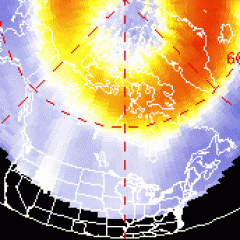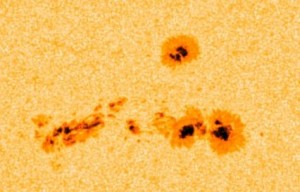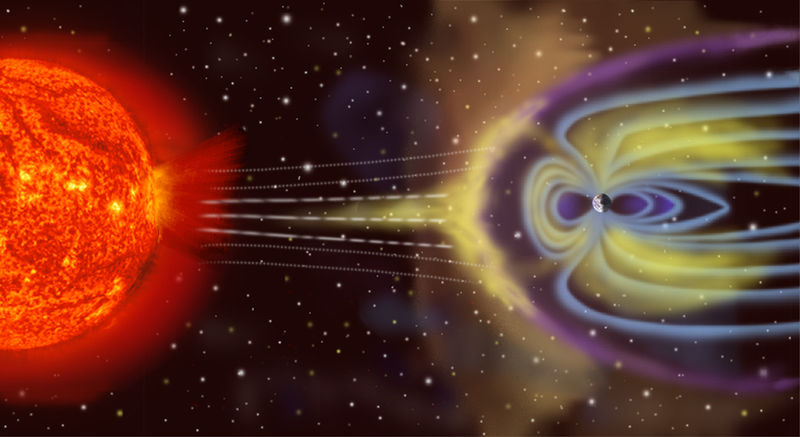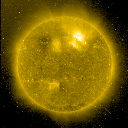Wheat harvest is in full swing in Canada, and with only one confirmed crop circle in North America found 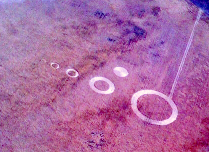 two months ago at Wilbur, Washington, the prospect of my being able to get into one this year seems bleak. I must admit I long for the old days when I’d hear of a new crop circle and at the drop of a hat be immersed in my research – even if it means driving 17 hours each way, as happened with the North Dakota circles in 2000.
two months ago at Wilbur, Washington, the prospect of my being able to get into one this year seems bleak. I must admit I long for the old days when I’d hear of a new crop circle and at the drop of a hat be immersed in my research – even if it means driving 17 hours each way, as happened with the North Dakota circles in 2000.
The lack of circle activity within reach has been disappointing, yes – but my interest has thereby turned to the deep solar minimum in which we’re seemingly entrenched, and which I’ve written quite a bit about. Interestingly, there’s an apparent connection with the 2009 crop circle season and solar activity. What I’ve observed in the UK crop circles seems to reflect what’s going on with our Sun and its impact on our DNA.
Our DNA is intimately connected to the Sun, the most radical life source in our immediate galactic environs. The heliosphere plays a critical role in our lives from the moment of conception, filtering incoming cosmic radiation and thus the number of muons penetrating our cellular structure and quite possibly impacting our unique DNA patterning.
With that I’ll go back, and back again, to the beginning of this train of thought: to the summer of 1996, and the Double Helix formation found in East Field. 
It just so happens that the summer that bore the DNA spiral also ushered in the lowest point in our last solar minimum, along with Hale-Bopp along with its companion, which curiously was seen by many but mysteriously ignored or invisible to other comet 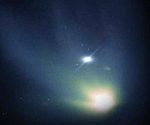 observers. Whatever was accompanying the comet was gone by the time Hale-Bopp emerged from around the Sun the next spring.
observers. Whatever was accompanying the comet was gone by the time Hale-Bopp emerged from around the Sun the next spring.
Well, since the 1996 solar minimum, the Sun’s activity and its relationship to our consciousness are becoming more and more curiously intertwined, and I’ve come to think of two 2009 formations in particular that support the idea that something of unpredictable magnitude (outside of Mayan prophecy, etc.) is occurring with the Sun and DNA’s relationship to it and, on a larger scale, to our galaxy and indeed to the cosmos itself – and subtly (or not) transcribed in the fields of England.
Anyway, we’ve come full circle, and then some. The summer of 2009 is stretched out so far ahead of 1996, yet here we are!
So back to the circles. I’ve done some thinking on the UK formations this year, and yes, I feel there’s but a distant relationship between the early phenomenon and what’s going on today. Okay, I acknowledge that most publicised formations these days are likely made by human teams – fine. Many of these crop artists claim to be in contact with a higher consciousness, and who am I to argue? I experienced communication with the circle makers in a different context, but it seems all of us who have had contact have no problem acknowledging the “other party.”
Beyond that, I sense a definite connection between the designs that were put in the fields this year and the exceedingly deep solar minimum in which we’re seemingly enmeshed.
That we’re transceivers of energy and information is a key to understanding the evolutionary leaps forward – and in many cases, the fallings back – that are occurring at seemingly increasing rates. The message has been distilled for a roundabout presentation to humanity in many ways, quite attractively (to me anyway) in the form of the crop circles in England this year. We saw the embryo of this concept in the season’s first formation, the Ridgeway “waveguide” near Avebury in April.

(diagram credit Andreas Muller – )
Certainly as the years have gone on the formations have become more deliberately representational – they’re much less abstract. Perhaps this is so that the phenomenon can reach a wider audience. Who knows? The  Ridgeway formation of April got the attention of many more people than the Thompson, North Dakota formation of 2000, into which only a handful of people stepped. (Diagram by me.)
Ridgeway formation of April got the attention of many more people than the Thompson, North Dakota formation of 2000, into which only a handful of people stepped. (Diagram by me.)
Ridgeway, which appeared to my friend Simeon and me to be a waveguide of sorts, could similarly be interpreted as a transceiver, just as biological entities such as ourselves are transceivers capable of absorbing and emitting electromagnetic radiation. Each individual is a transceiver of energy and information, and this remarkable gift if you will is a key to understanding the witnessed evolutionary leaps forward – and in many cases, the fallings back – that have truly become prolific, yet almost obscure, as we’ve entered the 2012 era.
Meanwhile the Sun lies in relative dormancy, its protective bubble shrinking and thereby allowing more galactic cosmic radiation into our solar system. We’re being infused with more and more energetic, extraterrestrial particles that would generally be stalled out at the heliopause, out beyond Pluto. With the influx of muons I would suspect that rapid untold effects on DNA are taking place as we speak. Remember that while the emphasis in mass media is on the potential dangers of these persistent cosmic rays, instinct reinforces that positive transformations may be occurring simultaneously.
On to the dramatic “jellyfish” formation, which was widely seen as the aetherial sea creature. The formation has also been interpreted as symbolic of Earth’s geomagnetic field deflecting solar radiation, which I find  more compelling. If viewed this way, the design seems to prophesy changes in Earth’s geomagnetic field as we are sandwiched between the sleepy Sun and the active cosmic rays entering from outside our solar system. Such a deflection scenario would radically impact human electromagnetic fields and DNA.
more compelling. If viewed this way, the design seems to prophesy changes in Earth’s geomagnetic field as we are sandwiched between the sleepy Sun and the active cosmic rays entering from outside our solar system. Such a deflection scenario would radically impact human electromagnetic fields and DNA.
Most of us, I think, don’t need an illustration on Wikipedia or elsewhere to conceptualise it. But plainly, there it is, in the crop circle. What do we make of this?
I suspect that DNA trends linked to individuals and the Sun’s activity immediately surrounding their conception will surely be understood by the scientific community soon, on the heels of the announcement that human DNA evolution is being actively tracked. For now, I rely entirely on piecemeal knowledge of science combined with an expanding level of intuition, which are also, thankfully, connected.
In gratitude.
STACE TUSSEL
